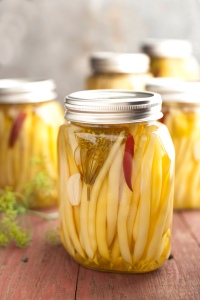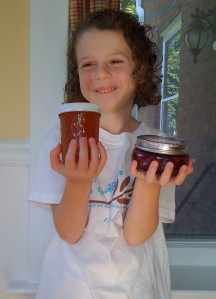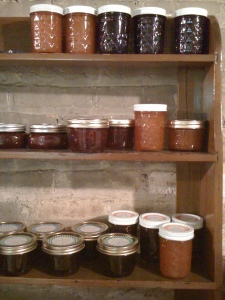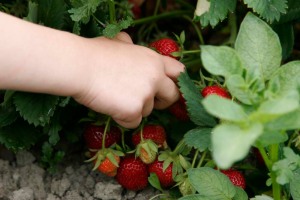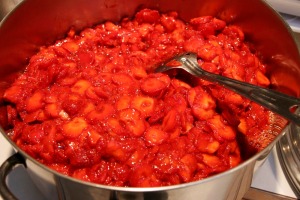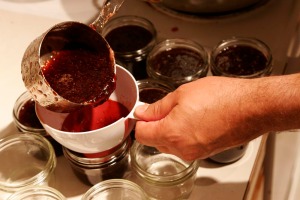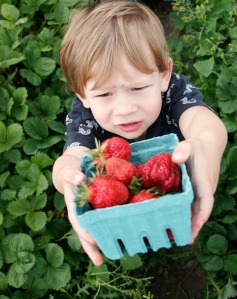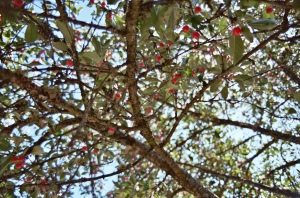
We are looking up into the trees, from wence cometh our ripe plums, and our necks are aching.
This is the day of our gleaning, and we are learning that picking free fruit has its rewards, both lascivious and beneficent, and its pains in the neck. The pains come first.
We are a group of eight, or nine, volunteers who have answered an email quickly on this balmy Thursday in July, we have come on bikes and rattley cars to this corner of Southeast Yamhill (seven blocks from my childhood home), to stand on the sidewalk with odd harvesting sticks and try our mightiest to dislodge only the perfectly purpley ripe plums. Splat. Splunk. Slllshhhh…. These are the sounds of the perfectly purpley ripe plums hitting the sidewalk, the parking strip, the vines in the house’s front yard, occasionally, our heads.
We are not very good at this, yet.
Perhaps it is a bit too early. The timing is the worst bit of gleaning; too early and you’ll stand under the tree, frustrated as you stand on tippy-toes with your 12-foot stick to reach the uppermost, sunniest branches where the fruit can be seen, glinting ripely in the early evening light, ending up with a modest harvest. Too late and the orbs will be all underfoot, splat splunk slllssshhh, sticking to the grubby running shoes you’ve worn for the occasion, many split and wormy and gooey. But we are here for charity, and after all this is free, so we do not complain.
I pick up the least smushed of the plums and figure I’ll feed them to the chickens, or make them into jam. I set them in my upturned helmet. And we fetch the orchard ladders from Katy’s pickup truck and climb for more.
Katy Kolker is a little bit famous, in that Portland-est of ways. She’s been quoted in the New York Times, and she wears a t-shirt that’s so muted it screams “sustainable rock star,” green on American Apparel heathery green. “Portland Fruit Tree Project,” it reads, if you’re up close, close enough so she can tell you something out of the Times, such as, “A fruit tree is really made for sharing with your neighborhood.”
She now works full-time for the Fruit Tree Project, which organizes “harvesting parties” where volunteers pick fruit from trees whose owners have (in her words) cried “uncle.” Half the fruit is given to a food bank; the other half is divvied and sent home with the volunteers.
The time is flying, and we decide that we’ve picked “all the reachable fruit” and head to the second harvesting outpost. I remove the several bruised and battered plums from my helmet and set it on my head, juice dripping into my hair. Oops. This spot is in my neighborhood, too, in the patio of an unusual business I’ve passed many times but never visited: a wine bar/nursery. I help move the lettuce and cauliflower seedlings out of the way as an older couple on a relaxed summer date look on, and we begin the most glorious harvesting exercise any of us could imagine.
The plums are tiny, just bigger than cherries, and the harvest is immense; they are lined up on rows up and down every branch, a child’s rendering of fruit, bounteous, bedeviling. As we stare up at the tree plotting our moves, they fall around us. I climb up onto the orchard ladder and I grab a branch and wait until the other volunteers are positioned below me with a tarp. And I shake.
It is perhaps the most effective possible method of harvesting just the ripe fruit; the soft plums fall and the rest hold stubbornly to their stems. I yield the shaking ladder to another volunteer harvester and it is after dark when we finally call it a day, left to sort the plums into “OK,” “good” and compost, and pick up the many overripe fruits we’ve crushed in our fervor.
All this while I am drinking in the heady scent of plumminess and dreaming of preserves. After we’ve sorted every last bit and Katy’s weighed the bounty, we stand around in a circle and say what we’ve enjoyed, and what we plan to do with our plums. Many of those assembled will take their seven pounds, eight ounces share home to eat fresh or to stew (with just a bit of cinnamon). I am making jam.
I fill my bag with “OK” fruit, soft and split and oh-so-fragrant, and I breathe it in, I already know what I will do: I will slip off the skins with my fingers, I will squeeze the flesh from the stones into a bowl, and repeat, repeat, repeat, four or five or six pounds’ worth of ripe, overripe, almost ripe plums, I will pour it into a wide stainless steel pot with a cup of honey and I will turn on the heat and I will inhale.
The aromas of preserving are as varied as the stars, each one surely better than the one before, each one a spike in the ground, laying the tracks toward a more perfect pantry, filled with (isn’t it?) all the earthly delights. I will swear that there is nothing that will bring me to tears as the scent of the first pot of strawberry jam, I will stir in calendula and borage blossoms, I will throw myself prone, weeping to the poet’s muse, and then I will stare deep into the eyes of a currant’s jelly and flit! my heart will be gone, again, besotted.
Tonight it will be plums. After an hour simmering, a night standing in the refrigerator awaiting my whim, I choose vanilla, and I bring the plum slurry back to a simmer. I prepare the jars (rinse in hot water, a quick dunk for the lids, rings at the ready), I bring my water bath ever-closer to 180 degrees, and with a generous hand stir in the vanilla extract. Ahh! I have never known love as this before (if it were not for blackberry-gooseberry, sans seeds, oh! symphonies in your name, my sweet-sour).
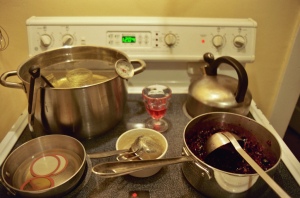
Into the jars, the plum vanilla jam, it goes, three half-pints and a pint, it is orange and glorious. Lids are secured, cans lowered into the near-bubbling vat of water, I barely glance at the clock to tell my beloveds how long they will tarry.
For I have plum pickles with star anise to can, too. I’m going to need more jars. Where else can I glean? And where can I get one of those harvesting sticks?
Ball lids, I set you as a seal upon my heart, for love of preserving is as strong as death. Oh, (pop!) my beloved is mine.
Sarah Gilbert is a writer, photographer, and mama of three little boys living in Portland, Oregon. She believes in baking bread, eating local, growing your own food and preserving as art. She writes for Culinate and at her own blog, Cafe Mama, and is working on a book on inconvenient food.


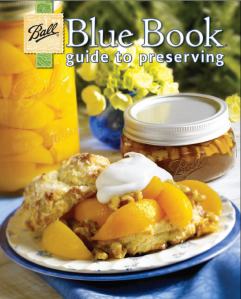
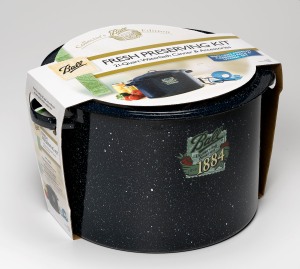
 This giveaway is made possible by the generosity of
This giveaway is made possible by the generosity of 